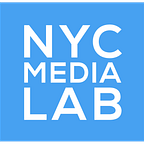Exploring Future Reality
Why now?
As recently as 2012, augmented and virtual reality was anything but “obvious” to most of the world. But work by researchers and developers in industry and universities in the three years since has refined the technology to record, create and view immersive content. Tech companies have led the way investing in augmented and virtual reality. Now they’re joined by global media companies such as Disney, which recently led a $65 million investment round in Jaunt.
“In 2015, leading technology and media companies, Comcast and NBCUniversal among them, realized that augmented and virtual reality is an exciting new medium. I expect this holiday season to support multi-million unit sales of consumer head-mounted displays (HMDs). Once demand is validated for hardware, content creators will surely follow — starting with games and then expanding into animation, live events, and film, which is why this is a highly relevant space for media and distribution companies,” said Gavin Teo, principal at Comcast Ventures.
Augmented and virtual reality hardware and content, it seems, are nearer than ever before to the consumer mainstream. Since 2014, notable examples of high profile augmented and virtual reality projects abound. Vice and the United Nations partnered with Chris Milk’s Vrse production company to produce “Clouds Over Sidra,” a spherical video that immerses the viewer in the daily life of a 12-year-old Syrian refugee in a Jordanian refugee camp. The International Champions Cup partnered with streaming virtual reality company NextVR to stream a match between Manchester United and FC Barcelona to the Samsung Gear VR. In late August of 2015, Discovery Communications launched its Discovery VR platform with a slate of virtual reality content they will grow over the next year. In November 2015 the New York Times launched the NYT VR app and distributed Google Cardboard viewers to a million home delivery subscribers.
When audience members recall a VR experience, it’s often as an active, lived experience.
Augmented and virtual reality appeals to media companies for its broad range of possibilities in both form and content. “We perceive virtual reality as not just a venue for advertising,” notes Steve Beres, west coast vice president of media and production operations at HBO. “We’re as interested, if not more so, in it as an opportunity for storytelling.”
Augmented and virtual reality is presently accessible to many consumers via their smartphones. Using Google Cardboard or the Samsung Gear VR, two accessories that turn mobile phones into head- mounted displays, consumers are wanting now only in content. Catering to this new audience, media producers must adapt to physical production concerns and experiment with cameras, software, distribution systems and displays. They also face decisions over whether to develop their technical talent in house, or build external partnerships. Media companies also face the challenge of auditing, evaluating, and adapting their core competencies, in order to decide which assets translate best to an augmented or virtual reality experience.
Evaluating existing content and migrating assets to an augmented or virtual reality platform remains one of many hurdles for media companies. While augmented and virtual reality promises to be a rich storytelling vehicle it is, as a nascent medium, still host to more craft than art. How will the visual language of augmented and virtual reality emerge, and who will lead that stylistic charge? Consider, for example, the creative evolution of film. “When Edison was making his early films in the 1890s, he had most of the technology needed to make a Hollywood feature film,” said Ken Perlin, of the NYU Media Research Lab. “It took decades to work out over the shoulder shots, two-shots and editing. It’s not about technology.”
The investment of time and resources in forging new augmented and virtual reality content may seem steep, but many media producers see first-person media as an important opportunity for immersing audiences in creative content as never before. Take, for example, a scene from HBO’s “Game of Thrones” virtual reality experience: Viewers find themselves in the virtual world of the show standing perilously close to the edge of a cliff. A physical response is inevitable, the viewer’s legs tense up, bracing against the seemingly unending drop. “You know you are standing in the middle of a conference room in Santa Monica, but your brain has that connection,” said Steve Beres. “You remember it like you did it, not like you watched it.”
When audience members recall a virtual reality experience it’s often as an active, lived experience. While one might remember a good film, that memory is filtered from a fixed, distant perspective. In virtual reality, the viewer is in the midst of the story. “Virtual reality brings up fuller types of feeling,” said Juan Santillan, CEO of virtual reality live streaming company vantage.tv. “One being intimacy. I’m here at the concert, very close to my favorite singer. That type of closeness and intimacy is creating higher ranked emotions with users than what was being done before virtual reality.”
What this intimacy and closeness can achieve remains to be seen. Yet one interesting point persists: With virtual reality, the transaction between an audience and the story is fundamentally changed — and pared down. Established mediums, even when storytelling from a first person perspective, still rely on the removed — and unmoved — perspective of their viewer. Virtual reality bridges that gap, and in inspiring a lived memory makes this frontier of storytelling a shared creative act.
Exploring Future Reality is a report brought to you by NYC Media Lab. Download a PDF of the full report here.
Continue to part two of this ten part series.
Return to the Exploring Future Reality report homepage.
